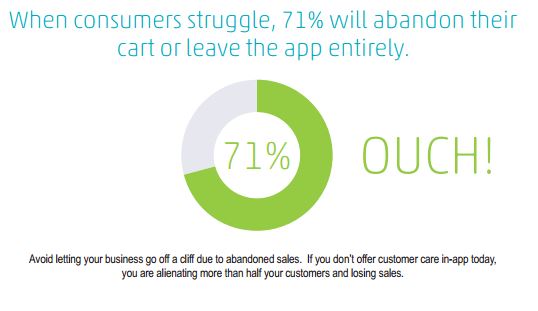Because of our growing reliance on personal mobile devices for everything, a lot of attention has been paid to making interactions over these devices customer-friendly, especially when it comes to using them as the preferred transactional platform for making retail purchases. Realities are that while retailers have made strides in making personal device interactions more compelling they are nevertheless falling short.
This is the conclusion from new research by cloud-based customer care specialists Contact Solutions, titled “Mobile Shopping Cliffhanger: Consumers Identify Big Gaps in Retail Shopping Apps.” The results should be a wake-up call to retailers. As the headline says, mobile shoppers have a very uncomfortable abandonment rate once they start their mobile online transactions. Retailers clearly need to up their game if they are going to seal these deals.
High customer expectations are not being met
This is a report worth downloading. What the survey of over 1,000 consumers found is that while consumers are taking to mobile shopping in a very impressive way, they come to retailer sites and apps with high expectations.
“Retailer investments in online and mobile shopping experiences are starting to pay off, but keeping the trend going requires much more attention to customer care,” said John Hibel, director of marketing for Contact Solutions. “Customers are using apps more frequently for shopping, but when they encounter problems and cannot get the help they need, the results are disastrous for retailers. The solution is simple – invest more in your app’s customer care offerings so it can meet your customers’ expectations and provide them with a seamless shopping experience.”
Here is some interesting food for thought from the report. First, the good news:
But, there is trouble ahead if not addressed.

Source: Contact Solutions, “Mobile Shopping Cliffhanger: Consumers Identify Big Gaps in Retail Shopping Apps” (click to enlarge)
Here are two thoughts, actually words to think about on all of this. These are MAYDAY and WebRTC.
The first refers to the popularity of the button on the Amazon Fire which puts the user in direct contact with a customer care agent with the simple push of a button. This is a true differentiated value being offered by Amazon to help obviously boost device sales, but it also is aimed directly at addressing that abandon rate. As has already been proven to be the case, when people get better help by pushing the MAYDAY button and connected to a live agent they buy rather than give up. In fact, according to people who have seen the numbers, the results are impressive.
The second, for those who may not be aware, refers to the real-time communications standard now in Chrome and Firefox browsers that allows for multimedia (voice and video) and multiple media (the ability to add things like chart and unified communications collaboration capabilities) sessions. WebRTC is what brings to life that MAYDAY user experience. It does so without the need for plug-ins to activate the real-time multimedia rich functionality. The good news is it exists in over 60 percent of the world’s browsers and the apps are flowing with contact centers helping drive adoption.
In short, if you are not evaluating WebRTC as the study says you may be in for a real cliffhanger when it comes to delighting and keeping your mobile customers. It would be better if your customers and not your company are the ones sending out Mayday alerts.